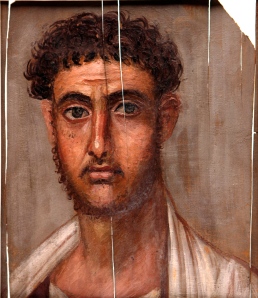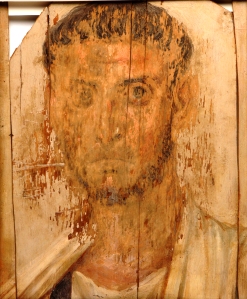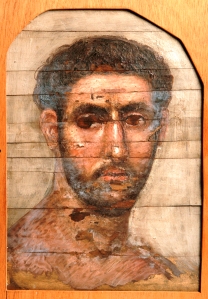This delicate wooden panel (41 x 32.5 cm) is one of 13 painted mummy portraits in the Manchester Museum. Such panel portraits were produced during the Roman Period (c. 55-220 AD) and are amongst the most evocative images to have come from Egypt. Most were painted using an encaustic method, in which pigment is mixed with hot wax and applied directly onto the surface of thin wooden panels. The panels were attached over the head of the mummy, held in place with bandages around each edge. Whether they were painted during life, and if they were displayed prior to being attached to the mummy, has caused much debate.
The practice of creating portraits developed out of the Pharaonic tradition of covering the head of the mummy with an idealised image of the deceased. Portrait painting had its roots in Roman traditions, and the portrait panels are the result of cross-fertilisation in the burial customs of Egypt’s multicultural society at this time. Painted portraits are attested at sites across Roman Egypt. Most are, however, associated with Hawara, a site in the Faiyum, from where the present example derives. The panels are often referred to as ‘Faiyum portraits’ because W.M. Flinders Petrie discovered over 700 examples in the region.
Unusually, this example bears an image on both sides. On one is painted the head and shoulders of a youthful man with a coiffure fashionable during the reign of the Emperor Hadrian (117-138 AD), and a rougher (partially erased?) sketch on the reverse perhaps represents a more mature version of the same man. A further panel (Acc. No. 5380) was found broken and bound within the mummy’s wrappings. This may depict the same man, but his hairstyle makes it more likely this painting adtes to the reign of Trajan (98-117 AD). Here the anonymous subject is shown with a bare chest – indicating athletic vigour, and perhaps also associated with emergence from cultic initiation. It may be suggested that each depiction was intended to represent a different aspect of the deceased’s identity, which could potentially survive by being enclosed within the individual’s burial.
Interestingly, once Petrie’s Faiyum portraits arrived in London – in most cases detached from the mummies they once covered – they were exhibited not in the British Museum along with other antiquities, but in the National Portrait Gallery. So evocative were these painted panels that they were valued in the same way as more modern, Western art. There is even circumstantial evidence that this exhibition of the portraits was seen by Oscar Wilde, and that the striking depictions of several handsome young men inspired the novel ‘A Picture of Dorian Gray’.
This illustrates rather well how Egyptian art – albeit from the Roman Period – can be divorced from its original context and reinterpreted in a new light. Between July and September, 10 of our painted portraits – including 5380 and 5381 – will be shown together for the first time at the John Rylands Library in Deansgate, along with contemporary papyri from the Rylands collection. The ‘Faces and Voices’ exhibition, curated by Dr. Roberta Mazza from the University’s Ancient History Department, will attempt to recontextualise these images in a unique way. We hope that both this exhibition and the permanent display of 12 of the portraits – including two still attached to mummies, as they were intended to be – will give us an opportunity to explore in greater depth the fascinating biographies of these objects.




Pingback: Faces&Voices – mummy portraits, papyri, and Egyptian contemporary art | NATURE TRAVEL EGYPT
Pingback: School Partnerships: The Art of Identity | Learning at Manchester Museum
Pingback: Understanding ancient Egyptian attitudes to animals | Egypt at the Manchester Museum
Reblogged this on hello future and commented:
We continue our countdown to the closure of our Ancient Worlds galleries with a post from Dr Campbell Price, Curator of Egypt and Sudan, on the topic of mummy portraits